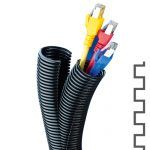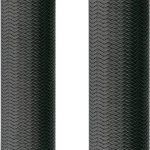
Machines in almost every industry are advancing at an unprecedented rate, with each new generation becoming faster than the previous. These new systems rely heavily on cables transferring power between them. Extra attention should be given to the state of these cables since a system can fail if a cable takes on too much strain.
By identifying the causes of cable strain and solutions for dealing with them, you can enhance the reliability of your machines, reduce operating expenses and protect individuals in close proximity.
Table of Contents
What Is Cable Strain?
Cable strain comprises the stresses a cable encounters that cause it to deteriorate over time. These stresses can be influenced mechanically, thermally, chemically and by other environmental factors. These elements may cause problems such as the cable’s jacket breaking open, exposing the interior, or the cable losing effectiveness over time to the point where it no longer functions.
Various things can go wrong from cable strain, such as machine failure or harm to both the rest of the system and people nearby.
Causes of Cable Strain
There are several potential causes of cable strain to look out for, such as:
Mechanical Influence
The way a cable is laid out can directly affect how much strain it takes on. Copper conductors and shields tend to experience stress when a cable is bent or flexed. The failure of the cable to flex most commonly occurs in the form of the shield and/or conductor fracturing at the flex area. In cases when the shield fails first, conductors will continue to work unless they receive electromagnetic interference (EMI) and/or radio frequency interference (RFI).
The combination of stresses from bedding and the vibration from moving cables will cause crimped solder cable terminations and connectors to fail. The fatigue occurs at the interface of the connector for unsupported cables. The insulation may also become degraded if it receives constant abrasions from other cables and equipment or if it is crushed by high compression forces. If the cable jacket deteriorates enough, then the cable’s interior can become exposed to liquid or abrasive particles.
Thermal Influence
There are times when a cable may have to operate in extreme temperatures because of weather conditions or the system’s excessive heat. In any case, cables exposed to intense environments can become brittle, melt or even catch on fire.
Chemical Influence
Cables may be operating within close proximity to various chemicals emitted from the machines or from cleaning being conducted as part of the system’s upkeep. These substances can cause cable jackets to erode and damage wiring. Even if the chemicals are rarely used, they may still negatively affect cables over long periods.
UV Influence
UV rays can place much strain on a cable’s integrity. Cables that come into contact with direct sunlight may face significant UV ray damage depending on the intensity of the light and the amount of time the cable is exposed to it.
Moisture/Liquid Influence
Water or other moisture around cables can lead to corrosion or mildew formation. If the water comes into contact with the wiring, malfunctions, electrical shorts and fires may occur.
Exposure to Rodents
Rodents in the area can also pose a large danger to a cable’s state. These animals are infamous for gnawing into cables to sharpen their teeth or set up nests. Instances like these can lead to various dangerous malfunctions.
Foot Traffic Exposure
When cables are laid in areas where people commonly walk, they will likely sustain increased strain from the foot traffic. The constant stepping on top of the cable will cause significant compression damage over time, like tearing or cracking.

How to Reduce Cable Strain
To minimize mechanical stress, keep the cable’s bend radius as large as you’re able to and make its diameter as small as possible. A smaller bend radius will create higher temperatures and a greater rate of fatigue, which can lead to insulation softening. Insulation softening may cause reduced cut-through resistance, tensile strength and protection from abrasion. Any of these changes may cause the cables to fail.
To decrease stress effects, use conductor and shield materials with higher tensile strength compared to copper. You should also keep cables still so they can maintain better resistance to bending. Don’t lay them limp. You can mount the cable to a panel or enclosure, which will prevent it from pulling out and overbending.
When setting up conductor insulation, you should use material that has high dielectric strength while maintaining adequate tear-resistance qualities. Make sure to keep the conductor insulation low. You can also optimize the reliability of your cables further by adjusting the cable and conductor lay, which is the number of twists per inch. You should also choose a jacket material that is thin, has high tensile strength, is resistant to tearing, and can withstand fluids and solvents.
Often, the first component to fail is the cable shield since it is farthest from the neutral axis, causing it to encounter the most stress. To fix this issue, you should replace the standard-braided shield with a double-served wire shield that is set up for flexing and effective shielding. Afterward, you should isolate the shield from the outer jacket and conductors to minimize friction, which will reduce heat and improve its flexibility.
If you must use cables in areas with high concentrations of chemicals, use extra precautions to make the cables chemically resistant. In cases where they are being used outdoors in direct sunlight, there are cable protection products that can be applied to help resist the radiation of UV rays. To protect against rodents, rodent-resistant braided sleeving can be used that will prevent cables from being gnawed through.
What Is Used in Electrical Wiring as Strain Relief
Some popular options for strain relief include:
- Braided sleeving: Made of braided polyamide, woven polyester or braided Fiberglass with silicone rubber coating, these sleeves are flexible and offer significant resistance to mechanical, abrasive and thermal forces. They also act as protection against rodents.
- Heat-shrink tubing: This plastic tubing is placed around cables and shrunk with heat. It boasts a small diameter from this process and is highly resistant to UV and chemical influence.
- Corrugated loom: Similar to corrugated conduits, with the exception of it being smaller, this option is great for improving cable durability indoors.
- Conduits: These products tend to be resilient, flexible, corrugated cylindrical protectants that safeguard cables by encasing them. The conduits available at AerosUSA are light and durable, especially against moisture.
- Vinyl tubing: This tubing acts as an excellent jacket for liquid-tight metal conduits. The exterior is made of vinyl, which makes it impenetrable against moisture and liquid.
Prevent Cable Strain Today
At AerosUSA, we provide unsurpassed cable protection and strain relief. We invite you to look through our products and see how they can best suit your cable strain relief needs. Or, for more information, feel free to contact us today.





